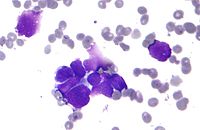
Photo from wikipedia
Background and aim Intrahepatic metastasis (IM) of hepatocellular carcinoma (HCC) occurs via vascular invasion; the tumor diameter that affects the risk of micro intra-hepatic metastasis (MIM) should be larger than… Click to show full abstract
Background and aim Intrahepatic metastasis (IM) of hepatocellular carcinoma (HCC) occurs via vascular invasion; the tumor diameter that affects the risk of micro intra-hepatic metastasis (MIM) should be larger than that which affects the risk of micro vessel invasion (MVI). The aim of the present study was to determine the optimum tumor diameter cut-off value for predicting the presence of MIM in HCC patients without treatment history and HCC patients with a treatment history and to compare these diameters between cases of MVI and MIM. Methods This retrospective study included 621 patients without macroscopic vessel invasion or intrahepatic metastasis on preoperative imaging who underwent hepatectomy. The cut-off tumor diameter for predicting the presence of MIM was determined by a receiver operating characteristic curves analysis. Results The optimum cut-off value for predicting the presence of MIM in HCC patients without treatment history was 43 mm. In contrast, the optimum cut-off value for predicting the presence of MIM in HCC patients with a treatment history was 20 mm. Among 46 HCC patients with MIM without treatment history, there were 20 patients with MIM without MVI who were considered to have potential multi-centric (MC) tumors rather than IM. The cumulative overall survival rates in patients with MIM without MVI (potential MC) was significantly better than that in patients with both MIM and MVI ( P = 0.022). Conclusions The tumor diameter cut-off value for predicting MIM differed between HCC patients without treatment history and with a treatment history and slightly smaller than those for predicting MVI beyond our expectation.
Journal Title: Clinical and Translational Oncology
Year Published: 2019
Link to full text (if available)
Share on Social Media: Sign Up to like & get
recommendations!